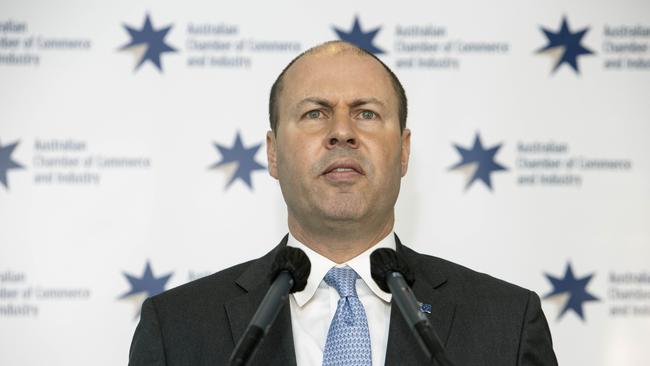Budget 2020: Josh Frydenberg’s repair jettisoned for jobs
Josh Frydenberg will prioritise jobs growth until unemployment is below 6 per cent.

Josh Frydenberg will prioritise jobs growth until unemployment is “comfortably” below 6 per cent, putting off budget repair for years in a major shift in the government’s fiscal strategy.
The Treasurer, in a speech to the Australian Chamber of Commerce and Industry, said “only through repairing the economy can we repair the budget”.
Mr Frydenberg’s comments were a significant change to the Coalition’s budget rhetoric of hitting surplus and driving down debt. He said the “recalibrated” strategy recognised the “current economic reality”.
The economy will be “persistently smaller” than forecast in December’s mid-year budget update as a result of the worst recession since the 1930s, Mr Frydenberg said. “A smaller economy, with lower price and wage growth, will generate less income for the government over the medium term,” he said.
By next June, real GDP will be 6 per cent lower than expected before the pandemic struck. In its July economic update, Treasury estimated government payments as a proportion of GDP would rise from 25 per cent to nearly 34 per cent in 2020-21.
On Thursday, Mr Frydenberg warned that over the medium term, spending was “still expected to be materially higher than pre-COVID levels as a share of GDP”.
Despite projections for elevated spending levels for longer, “it would now be damaging to the economy and unrealistic to target surpluses over the forward estimates, given what this would require us to do in terms of significant increases in taxes and large cuts to essential services”.
“This would risk undermining the economic recovery we need to bring hundreds of thousands more Australians back to work and to underpin a stronger medium-term fiscal position.”
Crucially, the October 6 budget will now predict negative net overseas migration in this and the next financial year, sending a major driver of economic growth into reverse.
Labor Treasury spokesman Jim Chalmers said the change of Mr Frydenberg’s approach to the surplus showed an “inconsistency” from the government.
“(They) pretended that debt and deficits a tiny fraction of what they are now were a disaster, and the end of the world, but now that they are many multiples of what they were a decade ago, they say it’s manageable,” he said.
But Dr Chalmers said it was difficult “to put any faith in the government’s new fiscal strategy when it never achieved its old one”.
“After promising nothing but surpluses the government has delivered nothing but deficits and record debt, even before the pandemic hit,” he said.
However, Deloitte Access Economics partner Chris Richardson said Mr Frydenberg’s updated budget strategy was “entirely sensible”.
Mr Richardson said the 6 per cent unemployment target would provide confidence to families that the government focus would be “on jobs, jobs, jobs”.
Treasury secretary Steven Kennedy has previously said he did not expect the jobless rate would fall below 6 per cent for four or five years. The employment outlook, however, has recently improved.
The jobless measure fell from 7.5 per cent to 6.8 per cent in August, after the economy added a surprise 110,000 jobs off the back of a surge in sole traders getting back to work. Mr Frydenberg said on Thursday that Treasury now expected unemployment to peak below 10 per cent.
Days ahead of the start of the phased removal of the government’s signature JobKeeper and JobSeeker supplement payments, Mr Frydenberg said the new fiscal strategy would be implemented in two stages, reflecting the “long-lasting effects on Australia’s economy” from the health crisis.
The first phase “is focused sharply on boosting business and consumer confidence and promoting jobs and growth”, he said.
“Our first priority must be to secure a strong and sustained economic recovery and drive the unemployment rate down as fast as possible.”
During this first phase, the government will let its “automatic stabilisers” work, by not raising taxes or cutting essential services. The government will also “continue to provide temporary, proportionate and targeted fiscal support, including through tax measures, to leverage private sector jobs and investment,” he said.
In conjunction with measures aimed at boosting spending, the government will “push ahead with structural reforms that position the economy for the jobs of the future and which improve the ease of doing business”.
Mr Frydenberg said while the government was prepared to oversee years of debt and large deficits, “our revised fiscal strategy is consistent with our core values”.




To join the conversation, please log in. Don't have an account? Register
Join the conversation, you are commenting as Logout